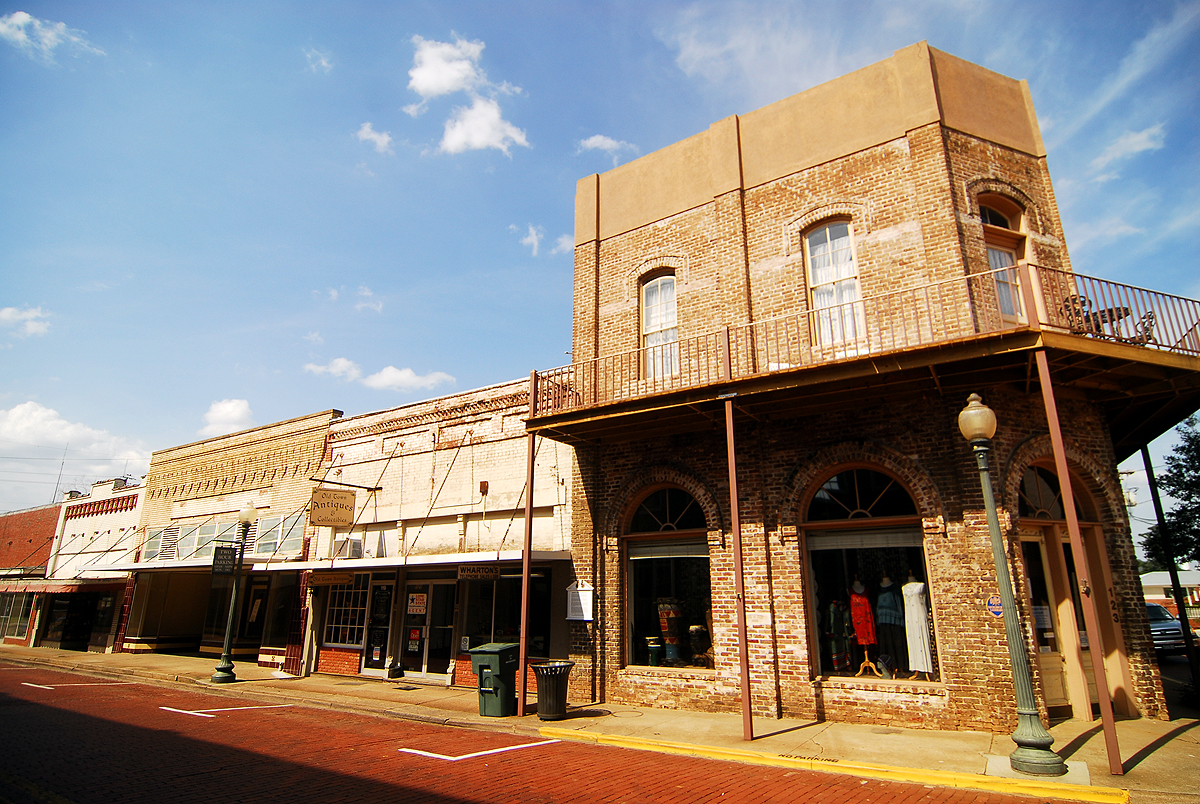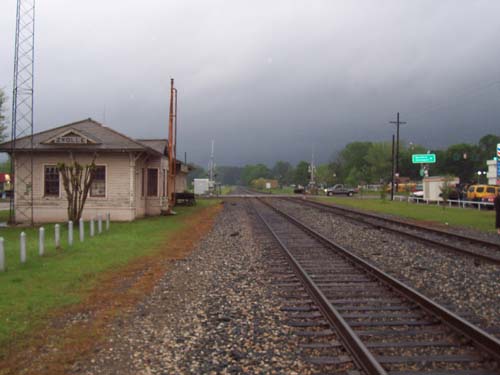Blue Highways: Nacogdoches, Texas
Unfolding the Map
Click on Thumbnail for MapWho knew that passing through Nacogdoches, we'd be passing through some of the most intense history in Texas? Rebellions, rebellions, rebellions. Here's where Texas gets its reputation for fierce independence. Click on the map thumbnail to see where Nacogdoches is located.
Book Quote
"...old Nacogdoches (not to be confused with old Natchitoches, Louisiana; Nacogdoches sounds as it looks, but Natchitoches comes out NACK-uh-tesh)."
Blue Highways: Chapter 4, Part 1
 Street scene in Nacogdoches. From the SkyscraperPage forum. Photo part of "photolitherland's" photo gallery. Click on photo to go to host site.
Street scene in Nacogdoches. From the SkyscraperPage forum. Photo part of "photolitherland's" photo gallery. Click on photo to go to host site.
Nacogdoches, Texas
In my last post, I wrote about Texas exceptionalism. Exceptionalism isn't uncommon - we all feel at times that the place we live or the country we inhabit is the best place on earth, for reasons that are obvious to us. In the case of Texas, part of that feeling comes from the fact that Texans are known for having a rebellious and independent spirit.
The Alamo in San Antonio is often singled out as being the ultimate symbol of Texan independence. In 1836, some 200-250 Texians fought Mexican General Santa Anna's army of 4000-5000 men for 13 days before succumbing, and through their act of sacrifice manage to inflame the rest of Texas which led to the defeat of the Mexican army at the Battle of San Jacinto a few weeks later.
I would argue, if the Alamo is Exhibit 1, then Nacogdoches might be Exhibit 2. Nacogdoches might not stir any recognition to the casual reader. However, you've heard of the Six Flags over Texas (no, not the theme park!). Texas as a territory has been subject to six different governments: Spain, France, Mexico, the Republic of Texas, the United States of America, and the Confederate States of America. But Nacogdoches claims nine different flags, and some of these flags were short-lived independent republics set up to challenge Spanish and Mexican sovereignty in the Texas before the Alamo became the ultimate Texan rebellion success story.
In 1812, a joint Mexican and American filibustering expedition of 130 men assembled in Nachitoches, Louisiana invaded Spanish Texas. In this context, filibusters are men engaged in unauthorized military expeditions against a foreign government. After the filibusters entered Texas, their number swelled to 300 and the expedition raised its flag over Nacogdoches and the rest of Northeast Texas, proclaiming what is now known as the Gutierrez-Magee Republic. The small force fought winning battles twice, at Goliad and at Rosilla, and executed the Spanish governor. However, despite a request for help to the United States government, the U.S. chose to not interfere, and the execution of the Spanish governor caused 100 Americans to quit the cause. The rebels were defeated in a final decisive battle at Medina.
Seven years later, James Long led another rebellion of about 300 men against the Spanish and established the first Republic of Texas (also known as the Long Republic) at Nacogdoches. Though Long established trading posts and the rebels began the first English language newspaper printed in Texas, the tiny republic lasted only one month. Long tried to get assistance from the pirate Jean Lafitte, not realizing that Lafitte was a double agent for the Spanish. The Spanish responded with a force of 500 men, forcing Long to withdraw back to Nachitoches, Louisiana. He attempted to raise another expedition from Galveston, but faced difficulties when a group of 50 Americans were arrested by U.S. authorities as they tried to cross into Texas. With a force of only 52 men, Long captured Presidio La Bahia at Goliad, but had to surrender four days later to Spanish troops. He was taken back to Mexico City, where six months later he was killed by a guard reportedly bribed by his onetime comrade and future governor of Texas for the Mexican government, Jose Felix Trespalacios.
The first attempt by Anglo settlers to secede from Mexico was centered around the creation of the Fredonia Republic near Nacogdoches in December of 1826, led by Haden Edwards. Edwards was an empresario, or a person granted the right to settle on Texas land in exchange for recruiting and taking responsibility for subsequent settlers. Mexico's policy in Texas was to grant rights to settlers from the United States so that it could better control its sparsely populated regions. Edwards was granted these rights, but appears to have misunderstood the extent of the powers granted to him. He assumed that he could evaluate already existing land grants, demand proof of ownership, and expel those that couldn't prove their ownership so that he could then parcel the land out to people from the southern U.S. The tension caused the Mexican government to revoke his land grant, which led to the rebellion. Edwards gained the alliance of the Cherokee nation. However, rather than rally other Texas settlers to his side, Edwards' actions alarmed other respected empresarios such as Stephen F. Austin (later to play a pivotal role in the Texas rebellion that gave Texas its independence). Austin actually sent men to assist the Mexican forces in putting down the rebellion. In January, 1827 as the Mexican forces approached Nacogdoches, Edwards fled back into the United States. However, while short lived, the Fredonia Rebellion had lasting implications. It fanned fears in the Mexican government that the United States was plotting to take over Texas, and thereafterward the Mexican government looked toward its Texas settlers with distrust. Mexico began to restrict immigration from the United States into Texas, leading to settler anger. It also made Nacogdoches instrumental in other Texian rebellions against Mexican authority right up to the Battle of the Alamo.
Overall, this spirit of independence and willingness to rebel against authority on the part of Texans, particularly Anglo settlers in Texas, has influenced a Texas worldview that seems to be part pride and part us-against-them. I experienced it in academia in Texas, where American politics courses are required to teach Texas government courses. Texas public schools must teach their students out of Texas government-approved textbooks - which means that textbook companies often make a general edition of their textbooks and a "Texas edition" of their textbooks.
It can be heard in the occasional less than serious talk of secession by Texas public officials such as Governor Rick Perry. In effect, these blusterings are merely what they are. My liberal friends in other places respond with "let them go." As a person who has lived in Texas, however, I know the real story. Texas needs the United States. It would not be able to afford the costs of being independent. However, what my friends don't realize is the other thing I know...the United States needs Texas. It needs Texas' natural resources, it needs its agriculture and it even needs its politicians, who for better AND worse have had significant impacts on the United States. It is a fascinating place with a fascinating history, and is part of the fabric of our country and our story. Texas history, since 1836, is United States history and as such, as complex and compelling as any we have to offer.
Sources: Wikipedia, History.com, Texas State Library and Archives Commission Online, Texas A&M online
If you want to know more about Nacogdoches
Nacogdoches Convention & Visitors Bureau
Nacogdoches Daily Sentinel (newspaper)
Stephen F. Austin State University
Texas Blueberry Festival
Wikipedia: Nacogdoches
Next up: Alto, Texas




 Tuesday, January 18, 2011 at 8:40PM
Tuesday, January 18, 2011 at 8:40PM

